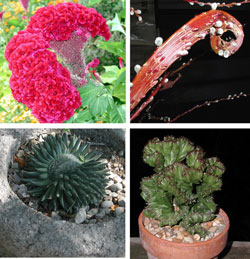Resource Library
Plant of the Week: Fasciated Plants (Crested Plants)
The University of Arkansas System Division of Agriculture does not promote, support or recommend plants featured in "Plant of the Week." Please consult your local Extension office for plants suitable for your region.
Plant of the Week
Fasciated or Crested Plants

As varied as they are, higher plants are built on more-or-less the same plan. All of these plants rely on a growing point - the apical meristem - to produce new parts and pieces.
These meristematic cells eventually transform themselves into leaves, stems and flowers. These meristem cells are biologically pliable, somewhat akin to human stem cells that have been so much in the news in recent years, but occasionally things go amiss.
One of the copying blunders that can occur as meristem cells divide is when they produce fasciated or crested growth. In normal cases, plant meristems are dome-shaped and produce a cylindrical stem. But, in fasciated plants, the meristem and then the stem itself flattens out and becomes elongated.
Fasciation can occur in about any kind of plant. Everything from dandelions to grapes will produce this unusual growth given the right circumstances. Gardeners, who are often attracted by oddball plants, have propagated some of these rarities. Fasciation is especially common in cacti and succulents, but willows, cockscomb and foxgloves also frequently show this abnormality.
Most now agree that fasciation occurs as a mutation in a single cell in the central zone of the meristem. This cell divides and gives rise to other cells in the next zone of development, the peripheral zone. Here the number of mutated cells increases dramatically and the growing point begins the process of differentiating into a mature meristem with nodes, leaves and flowers.
But, instead of the meristem being formatted to produce a round stem the mutation causes a disruption in between-cell communication and the flattened meristem results. French scientists have now identified two genes in Arabadopsis (the little cress that is the lab rat of plant research) that, when mutated, cause fasciation.
A number of things can cause the mutation to occur. Fasciation has been experimentally produced in seedlings using X-rays or chemical mutagens such as colchicine. In nature, it has been attributed to infection with various disease agents or insect infestation.
Of the disease-causing agents, the most commonly associated pathogen is relatively new group of organisms known as phytoplasmas - the Mollicutes in the modern classification scheme.
The phytoplasmas represent an evolutionary midpoint between cellular pathogens such as bacteria and non-cellular viruses. Phytoplasmas lack a protective cell wall but have a cell membrane, so they're difficult to see using conventional microscopy because when viewed inside a plant cell they appear as an amorphous blob.
It's likely that the association of insects with fasciation is due to their role as a vector for these or other pathogens. Grafting or cutting propagation is the usual means horticulturists use to propagate fasciated plants.
Some plants, notably cockscomb, transmit the fasciation characteristic by seed. The fasciated growth is probably caused by a permanent change in the genome of the celosia, possibly triggered by a phytoplasma infection at some point in the distant past.
If so, this is a case of natural genetic engineering. In some cases, seed-borne fasciation can be transmitted in the cell sap from the female parent to the offspring.
Fasciated plants have the same cultural requirement as their normal counterparts. While they're not especially common, it's always fun to keep an eye out for unusual forms of fasciation.
By: Gerald Klingaman, retired
Extension Horticulturist - Ornamentals
Extension News - February 22, 2008
The University of Arkansas System Division of Agriculture does not maintain lists of retail outlets where these plants can be purchased. Please check your local nursery or other retail outlets to ask about the availability of these plants for your growing area.